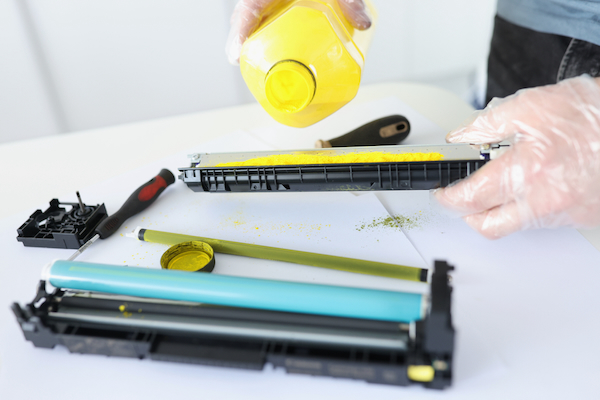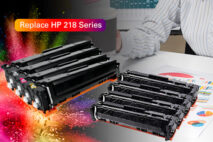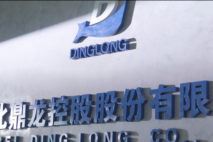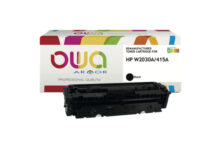We recently read a great blog on Armor-OWA.com explaining how the market for refurbished products is growing in Europe, in general, and in France, in particular. After offering some compelling facts and figures and market information about the growing demand for refurbished goods in Europe, however, the blog lurches to the conclusion that chips and firmware updates are what’s stymieing demand for remanufactured cartridges. While chip and firmware issues are a problem for remanufacturers, the biggest problem for European remanufacturers —as well as those in other regions—is the widespread availability of cheap new-build compatible cartridges, most of which can’t be remanufactured.
The blog was posted on November 30 to a website belonging to Armor Print Solutions, a division of the Armor Group. Based in Nantes France, the Armor Group is a global enterprise that had €447 million in revenue in 2022 and markets a range of products, including ribbons for thermal printing and filaments for 3D printing as well as third-party ink and toner cartridges. The Armor Print Solutions subsidiary offers an assortment of remanufactured products in its line of OWA-branded consumables, some made by Armor and some sourced from a third party.
Interesting Reading
To make its case that the market is trending towards refurbished products, the Armor Print Solutions blog examined the 2023 market for “refurbished and used mobile phones” in Europe. According to the post, which did not quote a source for its data, in 2023 refurbished phones accounted for 55.8 percent “of the European market for refurbished and used mobile phones.” Of the one in three consumers in France who own a refurbished product, the blog said, “Smartphones top the list of leading refurbished products (preferred by 45 percent of French people).”
Offering additional data from unidentified sources, the blog indicated that 67 percent of French consumers are “hesitant” to purchased refurbished products because they are concerned about quality or “they lack confidence in the platforms for refurbished products.” Regardless of such hesitation, Armor reported that 23 percent of “French people are thinking of taking the plunge in the coming months” and purchasing refurbished goods.
Bullish about the data, Armor perceives it as a “positive trend” for vendors offering refurbished and remanufactured goods, including itself. The blog noted the trend towards greater demand for reman products is supported by governmental initiatives like the European Commission’s Green Deal (see “Goodbye Voluntary Agreement on Imaging Equipment, Hello European Regulation”), which Armor says promotes so-called circular-economy products by:
- making sustainable products the norm in the European Union;
- giving consumers the means to choose;
- focusing on sectors that use the most resources and have a high potential to contribute to the circular economy; and
- guaranteeing less waste.
In addition to the Green Deal, the Armor blog mentions France’s anti-waste law, Anti-Gaspillage et pour l’Economie Circulaire—also known as AGEC. The aim of the law is to limit waste and support the transition to a circular economy by requiring products to be repairable and reusable. The AGEC promotes the use of recycled materials and recyclability and seeks to eliminate single-use materials like plastics used in packaging. According to Armor, starting in January 2022, public entities in France are required “to reserve at least 20 percent of their purchases for refurbished or reused products.”
After detailing so many major positive drivers that should be fueling demand for refurbished goods in the European market, the Armor blog concludes with some disappointing news for the imaging industry. According to the post, each year 70 million cartridges are sold in France “but only 15 percent of them are remanufactured.” While Armor sees the news as disappointing, it probably was not unexpected. Historically, return rates for empty cartridge have been in the low double digits and, thus the percentage of market share held by remans has been modest. From what Armor is reporting, it appears that has not changed in the European market.
Is the Role of Chips Overstated?
The Armor blog does not blame the low remanufactured cartridge rate in France on empties returns, however. Rather, the low rate of adoption of these cartridges in France—and presumably greater Europe—is “mainly due to the use of chips and firmware updates that block the remanufacturing market,” according to the blog.
We were frankly surprised when we read Armor’s conclusion and believe it is flawed. While chips and firmware updates have no doubt been an issue for remanufacturers, another market force is putting much greater downward pressure on reman demand. That pressure is coming from the widespread availability in Europe and other regions of cheap, new-build ink and toner cartridges imported from Asia.
Because they do not require pricy cores and can be produced with labor that is far cheaper than what’s required to pay workers in Europe, compatible ink and toner cartridges from Asia can are priced much lower than those domestically produced by remanufacturers. As a result, for more than a decade, Asian new-builds have commanded the lion’s share of the global third-party cartridge markets.
In addition to undercutting the price of remanufactured cartridges on the European market, new-build compatibles have polluted the pool of empties available to the remanufacturing industry. Unlike OEM cartridges, which can be refurbished, most cheap new-builds are made from components designed for a single use or materials unsuitable for recycling. Organizations that collect empty cartridges for remanufacturers are overwhelmed with empty “one and done” cartridges that must be disposed of either by burning or in landfills and that can’t be recycled.
It’s unclear why the blog on Armor-OWA.com didn’t mention the adverse impact that cheap new builds are having on Europe’s remanufacturing industry. With a large plant in Morocco, Armor is a major producer of remanufactured toner cartridges and must be aware of the problems compatibles cause for core collections.
Perhaps the French firm doesn’t want to ruffle any feathers. The firm sources its refilled third-party ink cartridges from Beihai Jixun Technology Co., Ltd., an inkjet cartridge remanufacturer based in China that is also known by its English name Speed Infotech. Recently, Speed Infotech revealed that it is planning to ramp up its production of new-build ink cartridges (see “Speed Infotech Posts Mixed H1 2023 Financial Results, Discusses Expansion into New-Build Compatibles”). It seems unlikely that Speed’s new-build products will be marketed under Armor’s OWA brand, however. According to the French company’s website, OWA cartridges are 100 percent “recovered.” Amor claims, “By choosing an OWA brand product, the buyer also gets the guarantee that this product will be collected, sorted, recycled or remanufactured and reintroduced into the industrial system.”
While we may scruple with the conclusion that the Armor OWA blog reaches, we thought the post made for good reading. It underscores the steps that are being taken in Europe to support the market for circular-economy products. It may offer a ray of hope for Europe’s beleaguered remanufacturers.






